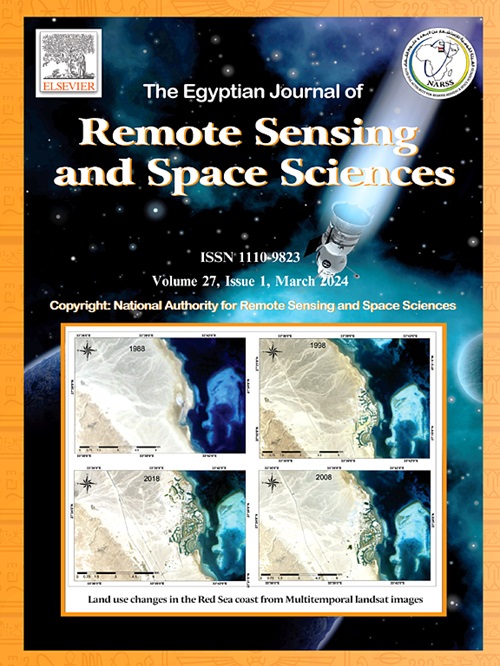SpecSpatMamba: an efficient hyperspectral image classification method integrating spectral-spatial dual-path and state space model
IF 4.1
3区 地球科学
Q2 ENVIRONMENTAL SCIENCES
Egyptian Journal of Remote Sensing and Space Sciences
Pub Date : 2025-10-08
DOI:10.1016/j.ejrs.2025.10.001
引用次数: 0
Abstract
Current hyperspectral image classification methods face three critical limitations: (1) traditional CNNs suffer from the curse of dimensionality when processing high-dimensional spectral data, leading to overfitting and poor generalization; (2) existing approaches fail to effectively address spectral band redundancy, resulting in computational inefficiency and suboptimal feature representation; (3) conventional methods lack synergistic utilization of spatial-spectral information, treating spectral and spatial dimensions uniformly rather than exploiting their distinct characteristics. To address these gaps, this paper proposes SpecSpatMamba, a novel hyperspectral image classification method integrating spectral-spatial dual-path feature extraction with state space models. SpecSpatMamba introduces three core innovations: (1) Dual-path feature extraction with spectral-spatial separation, where 1 × 1 convolutions extract spectral features and 3 × 3 convolutions capture spatial features; (2) Hybrid architecture combining state space models with convolutional operations for balanced long-range dependency and local feature capture; (3) Computational efficiency breakthrough achieving O(L·d) linear complexity compared to Transformer’s O(L2·d) complexity. Experiments on four benchmark datasets—Indian Pines, Pavia University, Salinas Valley, and Houston2013—demonstrate competitive performance compared to state-of-the-art methods. SpecSpatMamba achieves overall accuracies of 95.11 %, 98.61 %, 96.97 %, and 91.48 %, respectively. Notably, SpecSpatMamba demonstrates superior cross-dataset consistency and robust performance across diverse geographic environments, with particularly strong improvements in complex urban scenarios (+0.39 % on Houston2013) and agricultural settings (+0.57 % on Salinas Valley), confirming the method’s effectiveness in addressing high-dimensional hyperspectral data challenges.
SpecSpatMamba:一种结合光谱空间双路径和状态空间模型的高效高光谱图像分类方法
目前的高光谱图像分类方法面临三个关键的局限性:(1)传统cnn在处理高维光谱数据时存在维数诅咒,导致过拟合和泛化差;(2)现有方法无法有效处理频谱冗余,导致计算效率低下,特征表示不理想;(3)传统方法缺乏对空间光谱信息的协同利用,对光谱和空间维度进行统一处理,未能充分挖掘其各自的特征。为了解决这些问题,本文提出了SpecSpatMamba,一种将光谱-空间双路径特征提取与状态空间模型相结合的新型高光谱图像分类方法。SpecSpatMamba引入了三个核心创新:(1)光谱-空间分离双路径特征提取,其中1 × 1卷积提取光谱特征,3 × 3卷积捕获空间特征;(2)结合状态空间模型和卷积运算的混合架构,平衡远程依赖和局部特征捕获;(3)与Transformer的O(L2·d)复杂度相比,计算效率突破,实现了O(L·d)线性复杂度。在四个基准数据集(indian Pines、Pavia University、Salinas Valley和houston 2013)上进行的实验表明,与最先进的方法相比,它们的性能具有竞争力。SpecSpatMamba的总体准确率分别为95.11%、98.61%、96.97%和91.48%。值得注意的是,SpecSpatMamba在不同地理环境中表现出卓越的跨数据集一致性和稳健的性能,在复杂的城市场景(休斯顿2013年+ 0.39%)和农业环境(萨利纳斯山谷+ 0.57%)中表现出特别强的改进,证实了该方法在解决高维高光谱数据挑战方面的有效性。
本文章由计算机程序翻译,如有差异,请以英文原文为准。
求助全文
约1分钟内获得全文
求助全文
来源期刊
CiteScore
8.10
自引率
0.00%
发文量
85
审稿时长
48 weeks
期刊介绍:
The Egyptian Journal of Remote Sensing and Space Sciences (EJRS) encompasses a comprehensive range of topics within Remote Sensing, Geographic Information Systems (GIS), planetary geology, and space technology development, including theories, applications, and modeling. EJRS aims to disseminate high-quality, peer-reviewed research focusing on the advancement of remote sensing and GIS technologies and their practical applications for effective planning, sustainable development, and environmental resource conservation. The journal particularly welcomes innovative papers with broad scientific appeal.

 求助内容:
求助内容: 应助结果提醒方式:
应助结果提醒方式:


